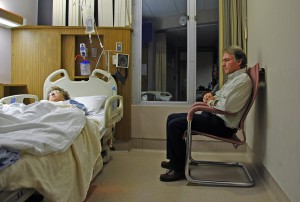This website uses cookies so that we can provide you with the best user experience possible. Cookie information is stored in your browser and performs functions such as recognising you when you return to our website and helping our team to understand which sections of the website you find most interesting and useful.

Susan E. Mazer, Ph.D. Blog
Thoughts and ideas on healthcare
Hi, and welcome to my blog! I'm Susan E. Mazer -- a knowledge expert and thought leader on how the environment of care impacts the patient experience. Topics I write about include safety, satisfaction, hospital noise, nursing, care at the bedside, and much more.
The Environment of Care as Palliative Care
November 14, 2014
 Florence Nightingale said that the environment of care holds within it the key to relieve both pain and suffering. And, the inverse is also true: it can exacerbate pain and suffering.
Florence Nightingale said that the environment of care holds within it the key to relieve both pain and suffering. And, the inverse is also true: it can exacerbate pain and suffering.
A study published this week by McMaster University about what patients find most valuable to discuss at end of life care revealed that most of the time decisions are based on what is prescribed rather than what is preferred.
To know patient preference, patients must share their most personal desires and fears. This requires an openness and trust that allows for intimate, candid, and often painful conversations. For this reason, among others, the patient environment must itself be palliative.
Noise, glare, tangled sheets and blankets, clutter, four walls that do not change — the room can close in on patients who are unable to move from the bed or care for themselves.
Creating and sustaining a palliative environment means that every detail contributes to optimizing the patient experience, making the most of the patient’s own capacities, and enhancing his or her comfort and safety.
The C.A.R.E. Channel has been used in so many situations that become palliative and sometimes morph into hospice. It has also held the hand of patients who eventually recover and share their experiences with us. Here’s a few of their stories:
“My mother is in hospice care at Providence Little Company of Mary Hospital in Torrance, CA. She is in a coma but I keep the TV on tuned to the healing health channel as it is soothing to those of us who spend time visiting her. I can only hope she can hear it and finds it comforting. The video is great also; my family enjoys watching it when we visit my mom.”
“While my father was in hospital, first in ICU then in hospice, we experienced C.A.R.E. for the first time. We were very impressed at the increase in serenity and true relaxation whenever C.A.R.E. was on. This is especially true after midnight when the visual theme changed to a space theme and the music became even more gentle and pleasing. I know it helped ease my father in his last days, and impressed me enough to inquire if it is possible to have the C.A.R.E. programming at home.”
“We recently had a 17 year old child admitted for inpatient hospice (first time we have admitted someone so young). She arrived from another hospital in Houston. It meant so much to her mother to have the bed covers pulled down and The C.A.R.E. Channel on. She said, “We couldn’t take her home, but seeing those pretty pictures with music and the covers pulled down, was about as close to home as you could get. It meant more to me than anything you could say.”
Patients and family members want to feel that you are aware of the stress of the situation and have prepared the room for them. They want an environment of care that respects and accommodates for the seriousness of the process of living and dying.
And, most amazing, as reported by a family member, what we do for them in their personal care environment is more important than anything we say to them. That’s the role of the environment.
P.S. If you like this post, please do me a favor and share on LinkedIn, Twitter, Facebook, etc. Also to get automatic notices when a new post is published, subscribe (upper right). No spam – just great content. Thanks!










